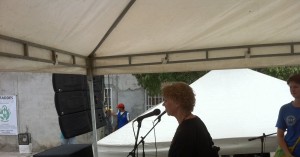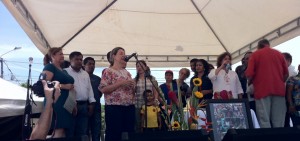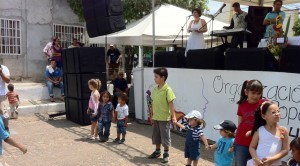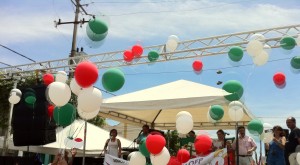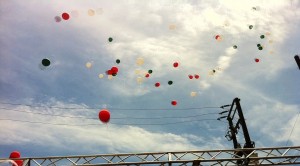Reflections on the 40th Anniversary celebration of the Organización Feminina Popular (OFP) by Susan Ferguson
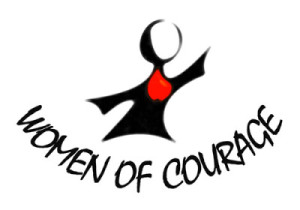
by Special Guest, Susan Ferguson
I was privileged beyond measure to attend this celebration of the OFP, an organization which has been a partner of KAIROS and the Latin America coalitions that preceded it for more than a decade.
I hope many of you have already read my partner Chris´s reflection posted earlier. Background information in that piece provides a vivid picture of the organization and what they are up against. Chris mentions that his reflection in the ceremonies was uncharacteristically short, and there were good reasons for that. Those of us bringing greetings from other countries and international organizations were at the end of a long line of speakers on a typically very hot day in Barrancabermeja. And you may also have noticed his reference to “nutritious local food”. This was a street food fair with many different women´s groups raising money to feed their families by selling cooperatively produced dishes, giving out information on the nutritional and cultural value of local foods, and participating in a contest to see which group would win the prize for the tastiest local cuisine.
The food was gorgeous, the smells were enticing and by about 2 o´clock when our turn finally came to speak the whole crowd (including us to be sure) were hoping to get to the food stalls ASAP. I brought greetings and expressed congratulations on behalf of the people and churches of Canada, and thankgiving that we in the north are better able to understand something of the real concerns of the Colombian people because we have this long relationship with the OFP. I also explained that I have not been long in Colombia and have many things to learn and begin to understand, so that this day was a special opportunity for me. Then I said what I believe, that this day of celebration signifies how important it is that we all stay committed to one another, even as we all share the commitment to work for a, a world of peace with justice and abundant life, the world God intends for us to live in.
The thoughts I want to share here started there, and have come more together since, after talking with the people, after seeing the excellent anniversary displays, after enjoying the local tamales and empanadas, after the bus trip back through the mountains to Medellín (as arduous and long as the trip there, but this time with rain-slicked roads).
What I have been moved to think about are the ways in which we can receive and use the gifts which these women indeed give us. How we who work to be faithful witnesses in Canada hear them, what we do with their example. Of course most of us do not work exclusively in women´s groups, and indeed the OFP has expanded to include committed men as well. But it is the work and the commitment of women that we focus on here.
I am very fortunate to have had experience living and working in several different parts of the world, in different parts of Canada, and with people from many other cultures newly arrived in Canada. Yes, these experiences inform my way of looking at things and being with people. But I have also spent a lot of time with Canadians, especially groups of women in our churches, who have not had this kind of exposure, who, if you will, “understand through faith” what I recount to them. I have often been impressed by their ability to enter into another reality through their contact with church partners, be it in study groups, or special worship experiences like the World Day of Prayer, by receiving and sharing with visitors as in the Women of Courage tour, or by talking with Canadians returned from “overseas” experience such as myself.
But I have also often seen that our engagement can focus on how impressed we are, seeing the women they hear about and meet as so special, so “amazing”, that they are engaged in ways we could never aspire to. This can make it difficult for us to “put ourselves in the picture” to move from informed and impressed to committed and proactive.
But one of the many blessings of long-term partnerships is that the understandings can expand as the relationships continue and deepen, that we can move to new levels. If we are truly celebrating not only the 40 years of struggle of the OFP, but also the long-term partnership of the churches of Canada with the OFP, I think we need to recognize where their grit comes from, to see that we indeed share many things, and to learn from them.
It is surely true that they are amazing women, and that there are unique gifted leaders and brave martyrs among them. The children who released the “Balloons of Hope” in pictures we sent had all lost their mothers, and these women´s lives are powerful sources of inspiration. But the women of OFP are at base ordinary women who are taken up with the needs of their families, and how their families are part of their community and their country.
And in their country, huge numbers of people are poor and getting poorer. Most live constantly with the threat and reality of violence, primarily from state and paramilitary groups. Colombia has the shameful distinction of the widest gap between rich and poor in the world, and the largest absolute number of people displaced within the country by violence, bar none, estimated now at more than 5 million. Women are often desperately worried about whether they will be able to feed their children, or get them safely to school, or get proper medical care.
In the sheer enormity of the concerns they face, Colombian women do differ from us. But women in Canada constantly confront similar concerns, especially around hunger and health care. Many Canadian women are privileged to have resources at their disposal to do this, but many others are not. But all have those same basic driving concerns for our families. So this is the basis of our understanding, when we look at the lives and concerns of the women in the OFP.
What do they do with their concerns? What methods do they use? What sustains them? As our partners, their concepts and their methods are available to us. When we look at these we can discern similar sources of energy available to us in our own context:
The key thing that gives energy and hope to the individual women of the OFP is that they have come together, that a woman in the OFP no longer need feel she is isolated with her problems. (The OFP Hymn says “Si nos unímos nadie nos vencerá” – “If we are united, no one can defeat us.”)
They base their work in what they know, at the local level, day-to-day. That food fair was part of a programme around food security which is grounded in the skills and talents and understanding of culture of women who struggle to put food on the table every day, despite the odds against them.
They use information and research in very practical ways, as with nutrition, or protection for people under threat by armed groups. AND also as documentation, to inform witness, protest, and advocacy. They do not opt for witness over service or service over witness. Each informs the other.
Their commitment and their work is very much grounded in their faith, but from early on was not confined to work within or through church structures.
They have a vision much wider than individual concerns, while committed to the goal of individual women achieving their own goals.
They include all age groups, and the younger people have very important roles to fulfill. In this way they insure that new leadership is constantly being developed.
They link with and cooperate with many different sorts of groups, as for instance labour unions, small local community organizations, national organizations like Kairos and Diakonia Sweden, and international organizations like Christian Peacemaker Teams.
They draw the line at certain links. For example, they are vibrantly patriotic, but will not accept government money as they understand that would compromise their activity, their independence and their good reputation. We can make similar judgments in the Canadian context.
We are all familiar with use of symbols, particularly in worship, but also in other gatherings as well. We often select symbols because of their positive universal associations (doves, flames, circles, hands joined, etc.).
Use of symbols is very important in the OFP, in what they do, in how they encourage one another and how they represent what they are doing, in how stand up to power. They use symbols that come directly out of their own experiences of work and protest. So the symbols have an immediate, visceral, impact. They link everyone to specific crucial moments and experiences, and thus have great power to educate and inspire.
Just a few examples:
La Olla – the cooking pot. A many-faceted symbol. References the commitment to feed people, and also their refusal as an organization, even though threatened and attacked, to supply meals to the paramilitaries who occupied their area of Barrancabermeja for years.
La Llave – the key to one’s premises. Again, the integrity of the family and the basic need for adequate shelter, but also refusal to allow entrance to OFP offices and access to files, even though under threat of violence and imprisonment.
La Trenza – the braid. Used in demonstrations, each woman holding a colour of cloth and the cloths braided together to form a rope. (Something like a horizontal maypole!) Brightly coloured material to call attention to themselves and what they are saying, the finished braid much stronger than its parts.
La Carta – the Letter. Represents the unceasing work to denounce unacceptable conditions and human rights abuses, efforts to get response from the government on these matters and its failure to provide mandated services and protect people. Also the constant communication with organizations seeking to advocate and to provide protection as they are often attacked in attempts to silence them and stop their work.
La Maquina a Coser– the sewing machine. One of the earliest symbols, this represents the way in which women first started to come together, as they only had permission from their husbands to gather together in “sewing cooperatives” to earn extra money for the family. Much more than sewing happened in those early groups!
As enriching as I found all these stories and symbols, another key image about the OFP I’ve not yet mentioned is their refusal to stop, to be silenced, or to silence themselves. In the Colombian context, and in Canada, this can happen. We see it happen all the time. We can stop talking, or talk too softly, or convince ourselves that we should not risk talking about what is really going on, about what people need, about how far we are from the world God wills.
Let´s turn again to the women at the tomb who Chris referenced in his appreciation of the women of the OFP. It´s not surprising that the different Gospels say different things. In Luke: “Our women amazed us.” In Mark: “they went out and ran from the tomb, distressed and terrified. They said nothing to anyone, because they were afraid.” In John it was only Mary Magdalene who went, and then: “told the disciples what Jesus had told her.” And in Matthew: “they left in a hurry, afraid and yet filled with joy.”
I think we often move between these different ways of reacting to events, to threats (and they were all under great threat before and after Jesus´ crucifixion), and to new possibilities. Perhaps the basic thing I hold onto from my day with the OFP is that if we are together, they and we can be afraid, and yet filled with joy.
